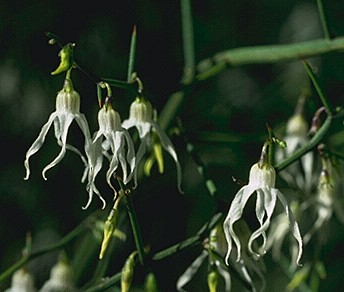
Synonymy
Anthocercis genistoides Miers, Ann. Mag. Nat. Hist., ser. 2, 11: 375 (1853)
T: south-western W.A., Drummond 86; syn: BM, K.
A. spinescens F. Muell., Fragm. Phytogr. Austral. 1: 122 (1859).
T: West Mt Barren, W.A. [Maxwell]; n.v.
Description
Erect, spinescent shrub to 3 m, leafy to almost leafless, mostly glabrous.
Leaves narrowly elliptic to linear or obovate, sessile, usually 5–30 mm long, up to 2 mm wide, entire, pubescent when young with mainly glandular hairs.
Flowers in axillary cyme-like clusters; pedicels 2–6 mm long. Calyx 1.5–3.5 mm long, pubescent inside. Corolla 8–25 mm long, pubescent inside, white to creamy-white, rarely pale yellow, the striations maroon, purple, brown or green; lobes narrowly triangular to linear, 4–20 mm long. Stamens 2.5–4 mm long.
Capsule ellipsoid, 6–8 mm long. Seeds 2 mm long.
Distribution and ecology
Endemic in south-western W.A.
Grows in scattered populations commonly associated with granite rock outcrops in sandy to sandy-loam soils.
Notes
A variable species; glabrescent forms in the Wongan Hills area approach A. anisantha Endl.
Sometimes confused with A. gracilis Benth., but distinguished by the spinescent habit, the shorter pedicels and calyx and the white corolla.
Selected specimens
W.A.: North Irwin, A.M. Ashby 3268 (AD, PERTH); c. 15 km SW of Ravensthorpe, L. Haegi 1036 (AD, CBG, NSW, PERTH); Moorine Rock, Mt Caroline, L.Haegi 1782 (BRI, CBG, MEL, NSW, PERTH).
Derivation of epithet
From Latin, meaning 'resembling Genista', a reference to the genus Genista, commonly known as broom.
Images and information on web
Images of this species can be seen on the FloraBase site at http://florabase.calm.wa.gov.au/browse/profile/6945
Pharmacology: A discussion of the tropane alkaloids which occur in Anthocercis and other Anthocercideae can be found in Griffith & Lin (2000).
Ref: W.J. Griffin & G.D. Lin (2000). Chemotaxonomy and geographical distribution of tropane alkaloids. Phytochemistry 53: 627–628.
References to the possible toxic properties of Anthocercis species can be found with a search in the
FDA Poisonous Plant DatabasePlant status (if any)
Without any declared rating in W.A. – see http://florabase.calm.wa.gov.au/conservationtaxa

